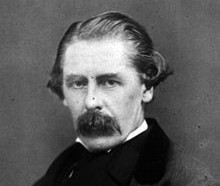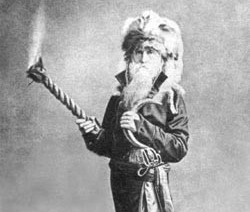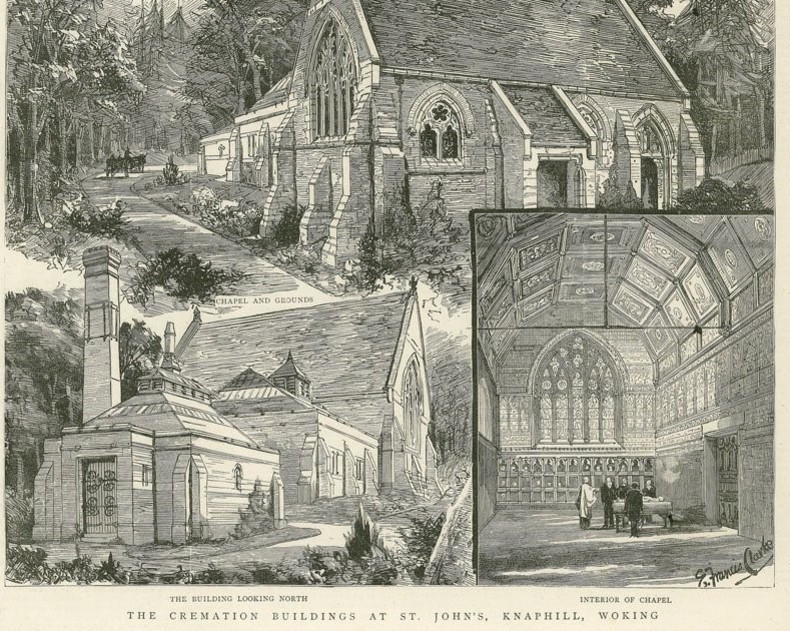Woking Crematorium History
Posted on 1st August 2019 at 12:10
Woking Crematorium - the first built in Britain

Cremation in Modern Britain
In 1866 practical experiments in cremation were made in Italy by Professors Gorini and Polli and in 1873, Professor Brunetti, of Padua detailed the results of his experiments and exhibited a model of his apparatus at the Great Exhibition in Vienna.
In 1874 Sir Henry Thompson, a surgeon and Physician to Queen Victoria, saw Brunetti’s models in Vienna and was very impressed. Thompson was a founder and first President of the Cremation Society of Great Britain and may justly be termed the father of the modern cremation movement. By his individual efforts and those of the early members of the Cremation Society, the practice of cremation was successfully introduced into Britain.
In 1878, with the aid of subscriptions at £200 each an acre of land was purchased close to St Johns Village, near Woking, from the London Necropolis Society for the foundation of the crematorium. The site was secluded and accessible, as the Necropolis Railway ran special funeral trains from Waterloo to Brookwood Cemetery.
The original simple furnace, constructed by Professor Paolo Gorini, was not enclosed in a building; a chapel and other buildings being added in the late 1880s.
The new crematorium was first tested on 17th of March 1879, when the body of a horse was cremated. The inhabitants of Woking showed strong antipathy to the crematorium and appealed to the Home Secretary, Sir Richard Cross, to prohibit the use of the building. The Cremation Society met with strong opposition from the Government.

Sir Henry Thompson (6th August 1820 – 18th April 1904)
In 1882 Captain Thomas Hanham, applied to the Cremation Society to carry out the cremation of the bodies of his wife and mother, but the Home Secretary objected. Hanham determined to carry out the cremations himself in a specially built furnace on his estate near Blandford, in Dorset. The cremations were a success and following his death a year later, his body was cremated there by his step-son; Honorary Secretary to the Cremation Society, Mr Swinburne-Hanham.
Only after cremation had been declared legal in February 1884, during Dr William Price's trial, could the Woking facility begin to operate.
Doctor William Price
Price was a Welsh doctor known for his support of Welsh Nationalism, Chartism and his involvement with the Neo-Druidic religious movement. He has been recognised as one of the most significant figures of 19th-century Wales, and one of the most unusual in Victorian Britain.
Gwenllian and William Price's first child was born on 8 August 1883, a son whom Price named Iesu Grist (the Welsh for Jesus Christ), in an act of provocation against the traditional religion of the time. However, the infant died, aged five months, on 10 January 1884. Believing that it was wrong to bury a corpse, thereby polluting the earth, Price decided to cremate his son's body, an act which at the time was taboo, although across the country there were already several proponents of it as a form of corpse disposal.
He performed the funeral in the early evening of Sunday 13 January 1884, at the summit of a hill to one side of Llantrisant in Wales. A number of local people noticed the fire, and upon discovering that Price was attempting to burn his infant son, surged on him. He was rescued from an angry mob by the police, who arrested him for what they believed was the illegal disposal of a corpse, and the body of his son, which had not yet been engulfed by the flames, was removed from the pyre.

William Price (4 March 1800 – 23 January 1893)
A post-mortem was performed on Iesu's body by a local doctor, who concluded that the child had died of natural causes and had not been murdered. Price was therefore not charged with infanticide, but was instead tried in a Cardiff courtroom for performing cremation rather than burial, which the police believed to be illegal.
Price argued that while the law did not state that cremation was legal, it also did not state that it was illegal either. The judge, Mr Justice Stephen (1829–1894), agreed, pronouncing that cremation was legal, provided no nuisance was caused to others during the process. Price was freed, and returned to Llantrisant to find a crowd of supporters cheering for his victory. On 14 March, he was finally able to give his son a cremation involving his own personal Druidic prayers. The case set a precedent which, together with the activities of the Cremation Society of Great Britain, led to the Cremation Act 1902.
First Official Cremation
On 26 March 1885, the first official cremation in the UK took place in Woking. The deceased was Mrs Jeannette C. Pickersgill, whom The Times described as "a well-known figure in literary and scientific circles".
Mrs. Pickersgill was cremated six days after her death. The great concern at the time was that the person may not be actually dead, and the thought of being burned alive was too shocking for the Victorians to contemplate. Two doctors were therefore required to certify Mrs. Pickersgill’s death. The cremation took one hour and 15 minutes. The notes in the cremation register record that the remains were taken, in the 20th Century, to Golders Green Crematorium's East Columbarium.
Mr Charles William Carpenter was cremated on the 19th October and in December the body of a fourteen stone woman was cremated. In 1886 ten bodies were cremated at Woking Crematorium. During 1888, in which 28 cremations took place, the Cremation Society planned to provide a chapel, waiting rooms and other amenities there.
The subscription list was headed by Herbrand Russell 11th Duke of Bedford and Hugh Grosvenor 1st Duke of Westminster. The Duke of Bedford later donated money to complete the buildings and to purchase ground adjacent to the property. The buildings were constructed in the character of English Thirteenth Century Gothic and were available for use in January 1891.
In 1892, 104 cremations were carried out at Woking. In 1902, Golders Green Crematorium was opened in London. In 1911, the original one acre site at Woking was extended to 10 acres and a Garden of Remembrance added.
Elected President of the Cremation Society in 1921, the 11th Duke of Bedford had the original cremator from Woking transferred to a new chapel at Golders Green Crematorium, where it was later used for his own cremation in 1940.



Cremations of note at Woking Among those cremated at Woking are:
John Douglas, 9th Marquess of Queensberry, died 1900, known for lending his name to the rudimentary rules for boxing and his involvement in the down fall of Oscar Wilde. (Ashes buried at Kidmountt Dumfriesshire).
Friedrich Engels, died 1895, philosopher and co-author with Karl Marx of the “Communist Party Manifesto” and “Das Kapital”. (Ashes scattered off Beachy Head, Sussex)
Hugh Grosvenor, 1st Duke of Westminster, died 1899, member of the Council for the Promotion of Cremation and Chairman of the Queen’s Jubilee Nursing fund – providing District Nurses for the sick and poor, through which he became associated with Florence Nightingale. (Ashes buried at St Mary's Church, Eccleston, Cheshire).
Thomas Hardy, died 1928, writer. Novels include; “The Mayor of Casterbridge”, “Tess of the d’Urbervilles” and “Far From the Madding Crowd.” (Ashes buried at Westminster Abbey; heart buried at St Michael's Church, Stinsford, Dorset).
Florence Hardy (née Dugdale), died 1937, writer, widow of Thomas Hardy (Ashes buried at St Michael's Church, Stinsford, Dorset).
William Ernest Henley, died 1903, poet (ashes buried at Cockayne Hatley, Bedfordshire)
Eleanor Marx, died 1898 (ashes buried next to her father's grave at Highgate Cemetery in London in 1956)
Rick Parfitt, OBE died 2016, guitarist with Status Quo 1967 to 2016.
Francis Russell, 9th Duke of Bedford, died 1891 (Ashes buried at St. Michael’s Church, Chenies, Buckinghamshire)
Elizabeth Russell, Duchess of Bedford, died 1897 (Ashes buried at St. Michael’s Church, Chenies, Buckinghamshire)
Philip Snowden, 1st Viscount Snowden, died 1937, first Labour Chancellor of the Exchequer. (Ashes scattered on Cowling Moor near Ickornshaw, Yorkshire)
Alan Turing, OBE FRS died 1954, computer scientist and code breaker. Turing played a pivotal role in cracking intercepted coded messages that enabled the Allies to defeat the Nazis in many crucial engagements, including the Battle of the Atlantic, and in so doing helped win the war. (Ashes scattered at Woking Crematorium)
There were 135 Commonwealth service personnel from both World Wars and thirteen holders of the Victoria Cross recorded to have been cremated here.
Tagged as: Woking Crematorium
Share this post:
